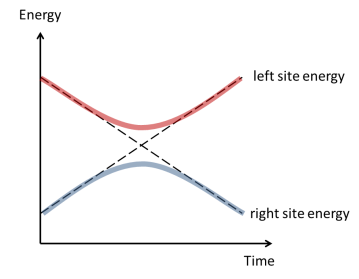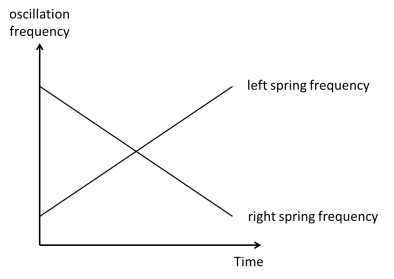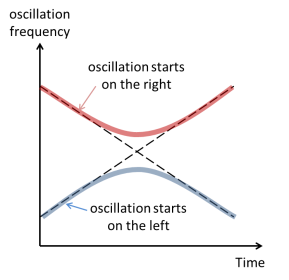There’s nothing particularly “spooky” about avoided crossing
Coming to terms with quantum mechanics is no easy task. The quantum world has its own unique atmosphere, its own set of laws and tendencies — its own tao, if you will — that seem far removed from the lifetime of solid-feeling intuition that all of us develop naturally. So gaining an ease and familiarity with the “quantum way” takes time. It’s a bit like living in a foreign country: you have to spend a lot of time immersed in it before you start to feel like you can move easily through its streets.
That said, those of us who spend a good chunk of our lifetimes thinking about quantum mechanics run a peculiar risk. Namely, we start to feel like quantum mechanics is everything, and that every result and every feature that appears in the quantum world must be understood on its own terms. In other words, we forget that some of the things that show up in the quantum world show up just as easily in the “person-sized” classical world, too.
One particular example is the phenomenon of “avoided crossing.”
In this post I’ll explain what avoided crossing is in its standard quantum form. Then I’ll show you that it can just as easily rear its head in the classical world, too.
Avoided crossing: quantum version
In its simplest form, the quantum phenomenon of avoided crossing goes something like this:
Imagine that there are two places where a quantum particle (say, an electron) can sit: a site on the left, and a site on the right. Suppose also that the site on the left has lower energy than the site on the right, and that an electron is sitting there. Like this:
Now suppose that you start to slowly raise the energy of the left site and lower the energy of the right site. Eventually, the two energy levels will pass by each other, and after a long enough time the left site will have a high energy and the right site will have a low energy. You would expect that during this process the electron will ride on the left site, so that its energy increases steadily. Like this:
But that’s not what happens. If you raise/lower the energies of the two sites slowly enough, then what happens is something like this:
In other words, the electron energy (the blue line) stays low, and never even gets as high as the point where the left and right site energies cross. What’s more, at long enough times the electron manages to transfer itself from the left site to the right site.
You can now ask the question: what would have happened if the electron started on the right site? Clearly, in this case the energy should be large to start, and should start decreasing with time as the energy of the right site drops. And that is indeed what happens, except that when the energies of the two sites get close to each other, something funny happens again:
The electron in this case manages to transfer itself from right to left, keeping its energy high, and never reaches the point where the two energies are supposed to cross.
So now if you make a plot of “energies that an electron can have” as a function of how far you’ve shifted the left and right site energies, you’ll get something like this:
This is the phenomenon of avoided crossing, or “level repulsion”. In short: you can never push two energy levels through each other. If you try, you’ll find that the two energy levels always get “repelled” from each other a little bit, and that the low-energy states remain smoothly connected to other low-energy states, while high-energy states remain connected to other high energy states.
So what causes avoided crossing? As you could probably guess, its existence depends crucially on the ability of the electron to jump from one site to the other. In other words, the avoided crossing arises from quantum tunneling. When the two sites have very different energy, you can say that the electron almost definitely resides in either one site or the other. Right at the crossing point, however, the electron finds itself spread between the two in a way that apparently involves the “spooky” laws of quantum mechanics.
A pause for philosphisizing
Let me pause here to make a more general comment concerning how we think about quantum mechanics.
In general, when one first encounters some strange phenomenon in quantum mechanics, like the avoided crossing outlined above, there are two courses of action, philosophically. One possibility is to just learn the phenomenon mathematically without grasping for a physical/mechanical way of thinking about it. The people who advocate this approach (as, for example, here) generally use the argument that all macroscopic “physical” objects really emerge from quantum mechanical laws applied across large scales, so trying to think about the quantum world in terms of mechanical objects is backwards and nonsensical.
This is true, of course. But it also strikes me as somewhat defeatist. Science, in my opinion, is never a business of compiling true statements. It is only a business of compiling useful concepts and models that give some predictive power. And for an idea to be useful, it has to be able to stick in your mind in a firm and conceptual way. An idea that consists of arbitrary laws or fiats is unlikely to stick in your mind (or at least in my mind) in this way, even if such fiats constitute a very correct way of stating the idea.
For me, at least, the only ideas that really stick in my mind are ones that can be thought of physically, i.e., ones that have some accompanying picture of how one thing pushes or shakes or distorts another. Even if these pictures are “not correct,” they are, to me, essential for scientific reasoning.
So let me not take the defeatist attitude of correctness, and try to come up with a “mechanical” way to think about the strange quantum business of avoided crossing.
Avoided crossing: classical version
Imagine for a moment that you have two springs, one on the left and one on the right, each connected to one of two equal masses. Let’s say that the spring on the left is fairly loose, while the spring on the right is tight. This means that if you excite the mass on the left it will vibrate slowly, like this:
On the other hand, if you excite the mass on the right, it will vibrate more quickly, like this: In this classical example, the vibration frequencies are the analogues of the electron energies in the quantum example above: to begin with, one is small and one is large.
In this classical example, the vibration frequencies are the analogues of the electron energies in the quantum example above: to begin with, one is small and one is large.
Now let’s imagine the process of slowly tightening the spring on the left and simultaneously loosening the spring on the right. This is like the simultaneous raising/lowering of the electron energies in the quantum example.
If the two springs are completely disconnected from each other, then nothing interesting will happen. The left spring frequency will gradually increase and the right spring frequency will gradually decrease. Like this:
But things become more interesting if you introduce a small coupling between the two springs. Suppose, for example, that we put a very weak spring in the middle, connecting the two masses. Like this:
Now, in principle, whenever either of the two masses moves it affects the other. But if the middle spring is very weak, then we can still excite mostly the left spring only or mostly the right spring only. For example, if you excite the loose left spring then the tight right spring won’t move very much. But what happens if you slowly tighten the left spring while simultaneously loosening the right spring?
As it turns out, this happens:
What you’re seeing here is that the oscillation starts out more or less entirely on the left, but as the two springs exchange roles (go from loose to tight and vice-versa), the oscillation moves to the right side. So you start with a slow, left-heavy oscillation at the beginning, go through a phase where both are oscillating equally, and end up with a slow, right-heavy oscillation at the end.
What would have happened if we had started with the oscillation on the right side?
This:
You’ll notice that the same thing is happening here, but in reverse. A fast oscillation in the tight spring on the right is eventually turned into a fast oscillation in the tight spring on the left.
If you plot what is happening to the oscillation frequency as a function of time, it looks like this:
Now that we have this picture, and a movie of what’s happening to the springs over time, we can talk about what, exactly, is the meaning of those funny “avoided crossing” states in the middle. These states correspond to the moment where the two springs are identically tight (the left and right spring are right at the point of exchanging roles). Apparently at this moment there are two possible frequencies that the system can have. If you started with the loose left spring oscillating, then by the time you get to the equality point the system will be doing this:
On the other hand, if you started with the right, tight spring oscillating, then at the equality point the system will be doing this:
 The first situation, where the two springs move together, has a lower frequency. This is generally called a “symmetric mode”, and it doesn’t involve any stretching of the central spring. The second situation is called an “antisymmetric mode.” It involves substantial stretching of the central spring and therefore has a larger frequency. (You can think that at any given moment, each mass in the antisymmetric mode has two springs pulling on it, while in the symmetric mode the central spring isn’t doing anything and each mass only has one spring pulling on it.)
The first situation, where the two springs move together, has a lower frequency. This is generally called a “symmetric mode”, and it doesn’t involve any stretching of the central spring. The second situation is called an “antisymmetric mode.” It involves substantial stretching of the central spring and therefore has a larger frequency. (You can think that at any given moment, each mass in the antisymmetric mode has two springs pulling on it, while in the symmetric mode the central spring isn’t doing anything and each mass only has one spring pulling on it.)
This is, essentially, the main point that produces avoided crossing in classical systems. When two oscillating things have some connection to each other, even if it’s weak, you can’t think anymore about exciting just one of them. Every oscillation you put into the system becomes a joint oscillation, and there are always two independent ways of making joint oscillations: a symmetric way and an antisymmetric way. These two independent ways will have different frequencies, because they necessarily place different demands on the connecting object (here, the central spring).
So how does this teach me anything about electrons?
If you start looking for commonalities between the two examples given here, one of the first you’ll see is that avoided crossing is associated with the transfer of something from one place to another. In the classical case, it was the transfer of an oscillation from one spring to another. In the quantum case, it was the transfer of an electron from one site to another.
At the moment when the two electron sites (or two springs), are made equal to each other, the electron (oscillation) becomes indifferent about which site to sit on. This means that the electron will sit on both sites equally. You can think that the electron finds itself jumping back and forth between the two sites. But there are two ways to do this: the electron can jump back and forth in a “symmetric way” or in an “antisymmetric way.” The “symmetric way” will always have lower energy.
Now, you can ask what is the meaning of calling the electron jumping “symmetric” or “antisymmetric.” The technically correct answer is that they relate to properties of the electron wavefunction, which is the mathematical function that describes the probability for the electron to occupy different places in space. In the symmetric state, the electron wavefunction is literally a symmetric function, while in the antisymmetric state the wavefunction is antisymmetric.
But let me try to be a bit more pictorial. It seems rude to invoke mathematical functions in a friendly discussion.
Quantum mechanics, in the end, is the theory of quantum fields. These fields are something like fluids that fill all of space, and electrons (or any other particles) are like little floating beads (or little floating bugs) that make a small disturbance in the field around them and are likewise pushed along by the field’s ripplings and frothings.

I’m not going to lie, sometimes my mental image for an electron looks kind of like this.
When we say that the electron sits at a given site, what we mean is that the rippling of the field is calm enough (or the confining environment is sturdy enough) that field ripples don’t take the electron very far from a particular point. But when two sites have very similar energy, the field can readily slosh back and forth between those two sites and take the electron with it. The more strongly connected these two sites are (for example, if they are physically very close), the faster will be the frequency with which the field sloshes back and forth, and thus the faster will be the frequency with which the electron jumps back and forth between the sites.
In my mind, the “symmetric way” for the electron to move is to go with the field — for example, to always ride on the crest of a “wave.” The “antisymmetric way” is to go against the field, which would imply that with each jump from one site to another the electron passes through a wave crest going in the opposite direction. Because the field is disturbed by the electron itself, the motion of the electron with or against the field alters the sloshing motion (this is something like my picture of Calvin in the bathtub). And thus the symmetric and antisymmetric states for the electron have different frequencies.
If you’re a pragmatic, quantitative-minded person, these supposed similarities between electrons and springs and sloshing waterbugs might all seem a bit wishy-washy. And at some level, they are. But for people who have to manipulate concepts in the quantum world, these kind of “visual” similarities can be very useful for building up a feeling for how the quantum world behaves. Real predictions require calculations, of course, but knowing which calculations are worth doing and what to expect requires feeling. And for me, at least, cartoonish pictures go along way toward creating those feelings.
It occurs to me, by the way, that if I ever become an old crackpot I might be pretty tempted to write a bizarre quantum mechanics textbook entitled “the electron as a water strider bug.”













Thrilled to see a new post here! Found GaL after some readings on marathons, and, incidentally, on mortality. Love the work, passion, and humor found within.
Yay – post! 🙂
But seriously, it’s nice to see it, was very interesting, and I hope you’ll be able to up the posting frequency
Thanks, guys, for the encouragement.
Hi, thanks for this enlightening post! There’s one question left:
You wrote “go through a phase where both are oscillating equally”. But isn’t this just the crossing that should be avoided, with both springs having the same frequency=energy?
Hi Bernd,
The point of the avoided crossing is not that both springs don’t have the same energy, but that both oscillation modes don’t have the same energy. Near the avoided crossing point, it is not possible to store the oscillation stably in only one spring or the other. Instead, any attempt will get the two-spring system oscillating in either a symmetric or anti-symmetric way. “Avoided crossing” is the fact that these two frequencies are different, and that they connect smoothly to situations where all of the oscillations belong to either one spring or the other.
Another way to say it is this: “avoided crossing” means that, as long as the two springs are at all connected, there is no way to make the system oscillate stably in two different ways with the same frequency.
Hi Brian,
Could you explain the intuition as to why you cannot have two modes with the same energy?
Thank you!
Ari
Hi Ari,
It’s possible to have two modes with the same energy, but it’s a special and rare situation. It requires some symmetry in the problem between two independent ways of vibrating the system. For example, if there is no central spring, then there is a left-right symmetry that guarantees your ability to make a left-only vibration or a right-only vibration with the same frequency. In a more complex example, there are similarly symmetries in the motion of an electron around a nucleus: you can make clockwise or counterclockwise rotations around the nucleus with the same frequency (this is what gives, in part, the degeneracy of the atomic orbitals).
However, the moment you do anything that either makes these two modes different from each other or introduces a force between them, the symmetry is lost and they cannot have the same energy. For example, an arbitrarily small central spring makes the left oscillation and the right oscillation no longer independent, and you get two different frequencies. In an atom, the electron interacts with the magnetic moment of the nucleus, and this splits the degeneracy between clockwise and counterclockwise motion. (This is called “hyperfine structure”.)
Does that help?
-Brian
excellent post…very clear and easy to understand…thanks a lot (I was reviewing some long lost Q.M.)
Thank you, I’m glad you found it helpful.
Thanks! That’s very interesting. But in a quantum system, we can have tunneling when the change the energies of the two electrons very fast in your example. I guess that would also happen in the mechanical example, right?
The existence of quantum tunneling between two states is the analog of my “little spring” between the two big ones. It is what communicates the particle (the spring oscillation) from one place to the other.
A really interesting article! Thank you!
I’m still pondering over the “sloshing of the quantum field.” And hell yah its gonna take quite a bit of time to sink in!
Thanks for writing so clearly in detail.
1. In the first paragraph under the section “Avoided crossing: quantum version”, there is a sentence “Suppose also that the site on the left has lower energy than the site on the left”, where the last one “left” should be “right”.
2. Can I take the last figures above the section “So how does this teach me anything about electrons?” as the similar reason of the gap in electronic band structure?
3. Some articles describe that the gap in electronic band structure is because of a standing wave near the boundary, can I take #2 as a result of standing wave too?
Thanks for any reply~
Thanks for catching my mistake!
As for band structure gaps, you’re right that it’s fair to think of them as arising from hybridization of two different electronic modes. Near the zone boundary, those hybridizations look like standing waves, as you said. I think of it something like the picture on slide 11 of this document: ww3.haverford.edu/physics-astro/songs/livingston/energybandslecture.pdf (taken from Kittel’s Introduction to Solid State Physics). The lower-energy standing wave has its electron density centered around the locations of ions in the unit cell, and the higher-energy standing wave is shifted away from them.
Hey, Brian, thank you so much for sharing the slide, and I also have found the describe in chapter 7 of Kittel’s Introduction to solid state physics.
For someone else’s information, a similar discussion is listed here: http://physics.stackexchange.com/questions/193420/why-are-band-maxima-minima-often-always-at-high-symmetry-points
This is an outstanding explanation! Thank you!
iv’e been trying to grasp this concept for a while now and I think that I finally got it.
It’s all because energy is quantized, doesn’t it? that means that the gradual change of the orbital energy is actually not continuous but ‘gapped’, the intersection of the two energy going up and down is located in this ‘gap’ so the point where they are equal doesn’t really exist.
Learnt a lot from this wonderful post! May I translate it to Chinese and post it on my own blog? I’ll refer to the original post.
Sure, go ahead. Thanks!
This is amazing!!
I have been looking for a properly explained analogy of anticrossings, and this is by far the best one I have found.
Thank you so much for taking the time to write this!
I was having difficulty trying to grasp the concept of avoided crossing. Your article made it very lucid. Thank you very much!
Electron rides symmetrically or antisymmetrically with the wave. Isn’t the electron itself the wave that is oscillating here and its symmetry and anti symmetry being decided by its shape around the nucleus?